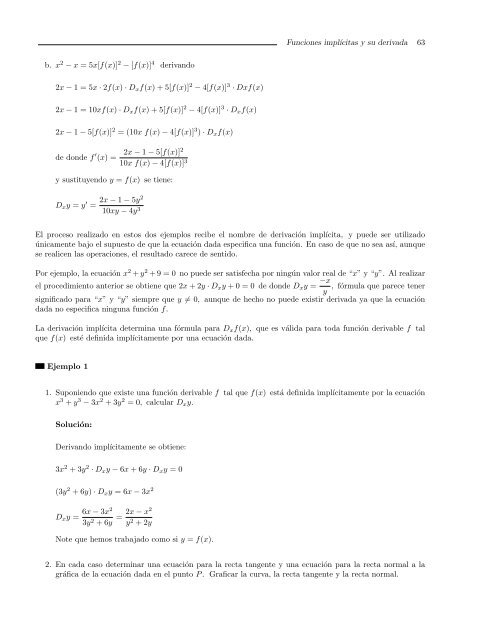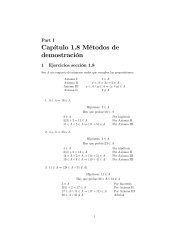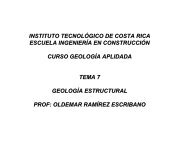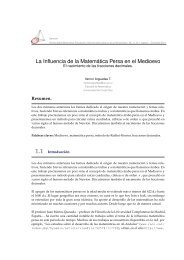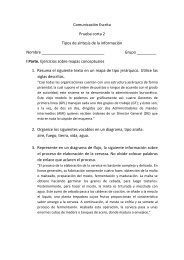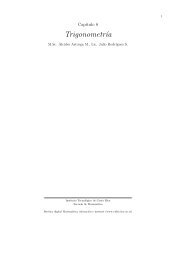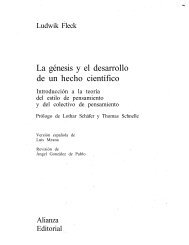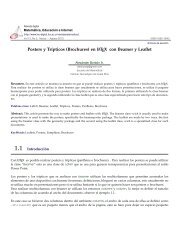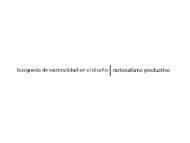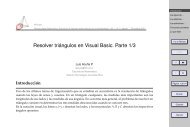Derivada de una función - TEC-Digital
Derivada de una función - TEC-Digital
Derivada de una función - TEC-Digital
You also want an ePaper? Increase the reach of your titles
YUMPU automatically turns print PDFs into web optimized ePapers that Google loves.
. x 2 − x = 5x[f(x)] 2 − [f(x)] 4 <strong>de</strong>rivando<br />
2x − 1 = 5x · 2f(x) · Dxf(x) + 5[f(x)] 2 − 4[f(x)] 3 · Dxf(x)<br />
2x − 1 = 10xf(x) · Dxf(x) + 5[f(x)] 2 − 4[f(x)] 3 · Dxf(x)<br />
2x − 1 − 5[f(x)] 2 = (10x f(x) − 4[f(x)] 3 ) · Dxf(x)<br />
<strong>de</strong> don<strong>de</strong> f ′ (x) =<br />
2x − 1 − 5[f(x)]2<br />
10x f(x) − 4[f(x)] 3<br />
y sustituyendo y = f(x) se tiene:<br />
Dxy = y ′ =<br />
2x − 1 − 5y2<br />
10xy − 4y 3<br />
Funciones implícitas y su <strong>de</strong>rivada 63<br />
El proceso realizado en estos dos ejemplos recibe el nombre <strong>de</strong> <strong>de</strong>rivación implícita, y pue<strong>de</strong> ser utilizado<br />
únicamente bajo el supuesto <strong>de</strong> que la ecuación dada especifica <strong>una</strong> <strong>función</strong>. En caso <strong>de</strong> que no sea así, aunque<br />
se realicen las operaciones, el resultado carece <strong>de</strong> sentido.<br />
Por ejemplo, la ecuación x 2 + y 2 + 9 = 0 no pue<strong>de</strong> ser satisfecha por ningún valor real <strong>de</strong> “x” y “y”. Al realizar<br />
el procedimiento anterior se obtiene que 2x + 2y · Dxy + 0 = 0 <strong>de</strong> don<strong>de</strong> Dxy = −x<br />
, fórmula que parece tener<br />
y<br />
significado para “x” y “y” siempre que y = 0, aunque <strong>de</strong> hecho no pue<strong>de</strong> existir <strong>de</strong>rivada ya que la ecuación<br />
dada no especifica ning<strong>una</strong> <strong>función</strong> f.<br />
La <strong>de</strong>rivación implícita <strong>de</strong>termina <strong>una</strong> fórmula para Dxf(x), que es válida para toda <strong>función</strong> <strong>de</strong>rivable f tal<br />
que f(x) esté <strong>de</strong>finida implícitamente por <strong>una</strong> ecuación dada.<br />
Ejemplo 1<br />
1. Suponiendo que existe <strong>una</strong> <strong>función</strong> <strong>de</strong>rivable f tal que f(x) está <strong>de</strong>finida implícitamente por la ecuación<br />
x 3 + y 3 − 3x 2 + 3y 2 = 0, calcular Dxy.<br />
Solución:<br />
Derivando implícitamente se obtiene:<br />
3x 2 + 3y 2 · Dxy − 6x + 6y · Dxy = 0<br />
(3y 2 + 6y) · Dxy = 6x − 3x 2<br />
Dxy =<br />
6x − 3x2<br />
3y 2 + 6y<br />
= 2x − x2<br />
y 2 + 2y<br />
Note que hemos trabajado como si y = f(x).<br />
2. En cada caso <strong>de</strong>terminar <strong>una</strong> ecuación para la recta tangente y <strong>una</strong> ecuación para la recta normal a la<br />
gráfica <strong>de</strong> la ecuación dada en el punto P . Graficar la curva, la recta tangente y la recta normal.


